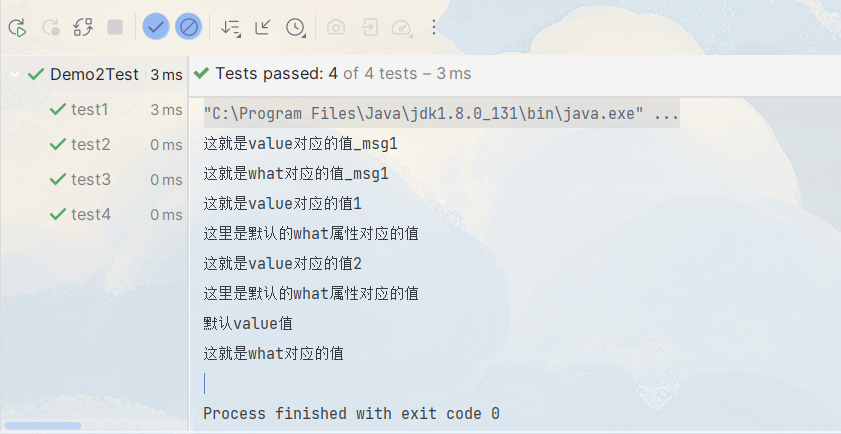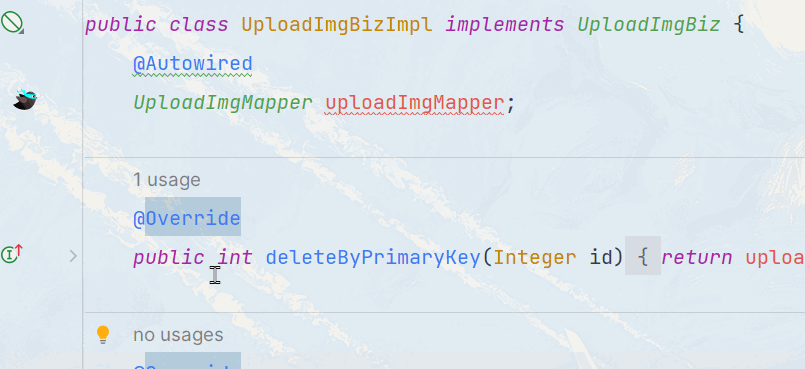一、SpringMVC之自定义注解
1.1 Java注解简介
注解(Annotation)是Java语言的一种元数据(metadata)机制,它提供了一种在代码中添加额外信息的方式。注解可以用于标记代码的特定元素,如类、方法、字段、参数等,以便在编译时、运行时或者通过工具进行处理。
注解相关类都包含在java.lang.annotation包中。
1.2 为什么要用注解
使用注解的主要目的是为了提供更多的元数据信息,以便在编译时或运行时进行处理。注解可以用于以下几个方面:
- 编译时处理:注解可以在编译时被编译器识别和处理。通过在代码中添加注解,我们可以告诉编译器执行特定的操作,如生成额外的代码、进行静态检查、生成文档等。例如,JUnit框架中的@Test注解用于标记测试方法,在编译时会被JUnit运行器识别并执行相应的测试。
- 运行时处理:注解可以在程序运行时通过反射机制被读取和处理。通过读取注解,我们可以获取代码中的元数据信息,并根据注解的定义执行相应的逻辑。例如,Spring框架中的@Autowired注解用于自动注入依赖,通过读取注解,Spring容器可以自动将依赖注入到相应的对象中。
- 工具处理:注解可以被工具读取和处理,以实现特定的功能。例如,JavaDoc工具可以读取代码中的注解,并生成相应的文档。其他工具,如代码生成器、静态分析工具等,也可以利用注解来实现特定的功能。
使用注解的好处包括:
提供更多的元数据信息:注解可以为代码添加额外的元数据信息,使得代码更加丰富和可读。通过注解,我们可以标记代码的特定含义、行为和规则,提高代码的可理解性和可维护性。
简化开发流程:注解可以简化开发流程,减少重复的代码和配置。通过使用注解,我们可以自动化一些常见的任务,如依赖注入、配置解析、路由映射等,提高开发效率。
增强代码的可靠性和安全性:注解可以用于进行静态检查和约束,以确保代码的正确性和安全性。通过在代码中添加注解,我们可以在编译时或运行时进行验证,避免一些常见的错误和问题。
**总之,注解是一种强大的元数据机制,它可以为代码添加额外的信息和行为,提高代码的可读性、可维护性和可靠性。通过使用注解,我们可以简化开发流程,提高开发效率,并实现更灵活和可扩展的功能。**
1.3 注解的分类 ⭐
1.3.1 JDK基本注解
JDK基本注解是Java开发工具包(JDK)中提供的一组预定义注解,用于标记代码的特定元素。这些注解包括:
- @Override:用于标记方法覆盖(重写)父类中的方法。当一个方法使用了该注解时,编译器会检查该方法是否正确地覆盖了父类中的方法。
- @Deprecated:用于标记已过时的方法、类或字段。当一个方法或类被标记为过时时,编译器会发出警告,提醒开发者不再推荐使用该方法或类。
- @SuppressWarnings:用于抑制编译器产生的警告信息。可以在方法、类或整个代码块上使用该注解,以忽略特定类型的警告。
1.3.2 JDK元注解
JDK元注解是用于注解其他注解的注解,它们提供了更多的元数据和行为来定义注解的行为。JDK中提供了四个元注解:
- @Retention:用于指定注解的生命周期。可以设置为SOURCE(只在源代码中可见)、CLASS(在编译时可见)或RUNTIME(在运行时可见)。
- @Target:用于指定注解可以应用的目标元素类型。可以设置为TYPE(类、接口、枚举)、METHOD(方法)、FIELD(字段)等。
- @Documented:用于指定注解是否包含在Java文档中。如果一个注解被@Documented注解修饰,那么它的信息将包含在生成的文档中。
- @Inherited:用于指定注解是否可以被继承。如果一个注解被@Inherited注解修饰,那么它的子类将自动继承该注解(不常用)。
@Target:指定被修饰的Annotation可以放置的位置(被修饰的目标)
@Target(ElementType.TYPE) //接口、类
@Target(ElementType.FIELD) //属性
@Target(ElementType.METHOD) //方法
@Target(ElementType.PARAMETER) //方法参数
@Target(ElementType.CONSTRUCTOR) //构造函数
@Target(ElementType.LOCAL_VARIABLE) //局部变量
@Target(ElementType.ANNOTATION_TYPE) //注解
@Target(ElementType.PACKAGE) //包注:可以指定多个位置,例如:
@Target({ElementType.METHOD, ElementType.TYPE}),也就是此注解可以在方法和类上面使用
1.3.3 自定义注解
自定义注解是开发者根据自己的需求创建的注解。通过自定义注解,开发者可以为代码添加特定的元数据信息,并定义相应的处理逻辑。自定义注解的创建步骤包括:
- 使用@interface关键字定义一个注解类型。
- 在注解中定义需要的元素,可以包括基本类型、枚举类型、Class类型、注解类型等。
- 使用元注解对注解进行修饰,例如@Retention、@Target等,以定义注解的生命周期和使用范围。
- 在代码中使用自定义注解,可以通过反射获取注解的元素值,并根据注解的定义进行相应的处理。
要创建一个自定义注解,你需要使用Java的注解机制。下面是一个简单的示例,展示了如何创建一个自定义注解:
import java.lang.annotation.ElementType; import java.lang.annotation.Retention; import java.lang.annotation.RetentionPolicy; import java.lang.annotation.Target; @Retention(RetentionPolicy.RUNTIME) @Target(ElementType.METHOD) public @interface CustomAnnotation { // 在这里定义注解的属性 String value(); }在上面的示例中,我们创建了一个名为
CustomAnnotation的注解。它有一个属性
value,可以用来传递一些自定义的信息。
通过自定义注解,开发者可以实现更灵活和可扩展的功能,如自定义验证规则、日志记录、权限控制等。自定义注解可以在类、方法、字段、参数等级别上使用,以满足不同的需求。
1.4 自定义注解三种使用案例
注解(根据Annotation是否包含成员变量,可以把Annotation分为两类):
- 标记注解(Marker Annotation):这种注解没有成员变量,它们仅通过自身的存在与否来提供信息。
例如:Java中的@Override注解就是一个标记注解,用于标记方法覆盖(重写)父类中的方法。
- 元数据注解(Meta Annotation):这种注解包含成员变量,它们可以接受和提供更多的元数据信息。元数据注解除了标记代码的特定元素外,还可以携带额外的数据或参数。通过元数据注解,我们可以为代码添加更多的元数据信息,以便在编译时、运行时或者通过工具进行处理。元数据注解可以用于配置、约束、验证等方面。
例如:Spring框架中的@RequestMapping注解就是一个元数据注解,它不仅可以标记请求处理方法,还可以指定请求的URL路径、请求方法、请求参数等。
1.4.1 案例一(获取类与方法上的注解值)
1. 定义一个枚举类:用来表示一组固定的值。
package com.ycxw.model;
public enum TranscationModel {
Read, Write, ReadWrite
}
2. 定义三个不同注解方式的类:
**MyAnnotation1 : **
package com.ycxw.annotation;
import java.lang.annotation.*;
/**
* MyAnnotation1注解可以用在类、接口、属性、方法上
* 注解运行期也保留
* 不可继承
*/
@Target({ElementType.TYPE, ElementType.FIELD,ElementType.METHOD})
@Retention(RetentionPolicy.RUNTIME)
@Documented
public @interface MyAnnotation1 {
String name();
}
**MyAnnotation2 : **
package com.ycxw.annotation;
import com.ycxw.model.TranscationModel;
import java.lang.annotation.*;
/**
* MyAnnotation2注解可以用在方法上
* 注解运行期也保留
* 不可继承
*/
@Target(ElementType.METHOD)
@Retention(RetentionPolicy.RUNTIME)
@Documented
public @interface MyAnnotation2 {
TranscationModel model() default TranscationModel.ReadWrite;
}
**MyAnnotation3 : **
package com.ycxw.annotation;
import com.ycxw.model.TranscationModel;
import java.lang.annotation.*;
/**
* MyAnnotation3注解可以用在方法上
* 注解运行期也保留
* 可继承
*/
@Target(ElementType.METHOD)
@Retention(RetentionPolicy.RUNTIME)
@Inherited
@Documented
public @interface MyAnnotation3 {
TranscationModel[] models() default TranscationModel.ReadWrite;
}
**Demo1测试类 : **获取类与方法上的注解值
package com.ycxw.annotation.demo;
import com.ycxw.annotation.MyAnnotation1;
import com.ycxw.annotation.MyAnnotation2;
import com.ycxw.annotation.MyAnnotation3;
import com.ycxw.model.TranscationModel;
/**
* 获取类与方法上的注解值
*/
@MyAnnotation1(name = "abc")
public class Demo1 {
@MyAnnotation1(name = "xyz")
private Integer age;
@MyAnnotation2(model = TranscationModel.Read)
public void list() {
System.out.println("list");
}
@MyAnnotation3(models = {TranscationModel.Read, TranscationModel.Write})
public void edit() {
System.out.println("edit");
}
}
Demo1Test测试类:
package com.ycxw.annotation.demo;
import com.ycxw.annotation.MyAnnotation1;
import com.ycxw.annotation.MyAnnotation2;
import com.ycxw.annotation.MyAnnotation3;
import com.ycxw.model.TranscationModel;
import org.junit.Test;
public class Demo1Test {
@Test
public void list() throws Exception {
// 获取类上的注解
MyAnnotation1 annotation1 = Demo1.class.getAnnotation(MyAnnotation1.class);
System.out.println(annotation1.name());//abc
// 获取方法上的注解
MyAnnotation2 myAnnotation2 = Demo1.class.getMethod("list").getAnnotation(MyAnnotation2.class);
System.out.println(myAnnotation2.model());//Read
// 获取属性上的注解
MyAnnotation1 myAnnotation1 = Demo1.class.getDeclaredField("age").getAnnotation(MyAnnotation1.class);
System.out.println(myAnnotation1.name());// xyz
}
@Test
public void edit() throws Exception {
MyAnnotation3 myAnnotation3 = Demo1.class.getMethod("edit").getAnnotation(MyAnnotation3.class);
for (TranscationModel model : myAnnotation3.models()) {
System.out.println(model);//Read,Write
}
}
}
运行list方法结果:
运行edit方法结果:
1.4.2 案例二(获取类属性上的注解属性值)
1. 自定义注解类:
package com.ycxw.annotation;
import java.lang.annotation.ElementType;
import java.lang.annotation.Retention;
import java.lang.annotation.RetentionPolicy;
import java.lang.annotation.Target;
//@Retention(RetentionPolicy.SOURCE)
@Retention(RetentionPolicy.RUNTIME)
@Target(ElementType.FIELD)
public @interface TestAnnotation {
String value() default "默认value值";
String what() default "这里是默认的what属性对应的值";
}
2. 定义测试类:获取类属性上的注解属性值
package com.ycxw.annotation.demo2;
import com.ycxw.annotation.TestAnnotation;
/**
* 获取类属性上的注解属性值
*/
public class Demo2 {
@TestAnnotation(value = "这就是value对应的值_msg1", what = "这就是what对应的值_msg1")
private static String msg1;
@TestAnnotation("这就是value对应的值1")
private static String msg2;
@TestAnnotation(value = "这就是value对应的值2")
private static String msg3;
@TestAnnotation(what = "这就是what对应的值")
private static String msg4;
}
3. 测试
package com.ycxw.annotation.demo2;
import com.ycxw.annotation.TestAnnotation;
import org.junit.Test;
public class Demo2Test {
@Test
public void test1() throws Exception {
TestAnnotation msg1 = Demo2.class.getDeclaredField("msg1").getAnnotation(TestAnnotation.class);
System.out.println(msg1.value());
System.out.println(msg1.what());
}
@Test
public void test2() throws Exception{
TestAnnotation msg2 = Demo2.class.getDeclaredField("msg2").getAnnotation(TestAnnotation.class);
System.out.println(msg2.value());
System.out.println(msg2.what());
}
@Test
public void test3() throws Exception{
TestAnnotation msg3 = Demo2.class.getDeclaredField("msg3").getAnnotation(TestAnnotation.class);
System.out.println(msg3.value());
System.out.println(msg3.what());
}
@Test
public void test4() throws Exception{
TestAnnotation msg4 = Demo2.class.getDeclaredField("msg4").getAnnotation(TestAnnotation.class);
System.out.println(msg4.value());
System.out.println(msg4.what());
}
}

1.4.3 案例三(获取参数修饰注解对应的属性值)
1, 创建自定义注解:
package com.ycxw.annotation;
import java.lang.annotation.*;
/**
* 非空注解:使用在方法的参数上,false表示此参数可以为空,true不能为空
*/
@Documented
@Target({ElementType.PARAMETER})
@Retention(RetentionPolicy.RUNTIME)
public @interface IsNotNull {
boolean value() default false;
}
2. 创建测试类:获取参数修饰注解对应的属性值
package com.ycxw.annotation.demo3;
import com.ycxw.annotation.IsNotNull;
/**
* 获取参数修饰注解对应的属性值
*/
public class Demo3 {
public void hello1(@IsNotNull(true) String name) {
System.out.println("hello:" + name);
}
public void hello2(@IsNotNull String name) {
System.out.println("hello:" + name);
}
}
3. 测试
package com.ycxw.annotation.demo3;
import com.ycxw.annotation.IsNotNull;
import org.junit.Test;
import java.lang.reflect.Method;
import java.lang.reflect.Parameter;
public class Demo3Test {
@Test
public void hello1() throws Exception {
Demo3 demo3 = new Demo3();
for (Parameter parameter : demo3.getClass().getMethod("hello1", String.class).getParameters()) {
IsNotNull annotation = parameter.getAnnotation(IsNotNull.class);
if(annotation != null){
System.out.println(annotation.value());//true
}
}
}
@Test
public void hello2() throws Exception {
Demo3 demo3 = new Demo3();
for (Parameter parameter : demo3.getClass().getMethod("hello2", String.class).getParameters()) {
IsNotNull annotation = parameter.getAnnotation(IsNotNull.class);
if(annotation != null){
System.out.println(annotation.value());//false
}
}
}
@Test
public void hello3() throws Exception {
// 模拟浏览器传递到后台的参数 解读@requestParam
String name = "zs";
Demo3 demo3 = new Demo3();
Method method = demo3.getClass().getMethod("hello1", String.class);
for (Parameter parameter : method.getParameters()) {
IsNotNull annotation = parameter.getAnnotation(IsNotNull.class);
if(annotation != null){
System.out.println(annotation.value());//true
if (annotation.value() && !"".equals(name)){
method.invoke(demo3,name);
}
}
}
}
}

二、Aop自定义注解的应用
2.1 自定义注解类
package com.ycxw.annotation;
import java.lang.annotation.ElementType;
import java.lang.annotation.Retention;
import java.lang.annotation.RetentionPolicy;
import java.lang.annotation.Target;
@Target(ElementType.METHOD)
@Retention(RetentionPolicy.RUNTIME)
public @interface MyLog {
String desc();
}
2.2 切面类
package com.ycxw.aspect;
import com.ycxw.annotation.MyLog;
import org.aspectj.lang.JoinPoint;
import org.aspectj.lang.annotation.Aspect;
import org.aspectj.lang.annotation.Before;
import org.aspectj.lang.annotation.Pointcut;
import org.aspectj.lang.reflect.MethodSignature;
import org.slf4j.Logger;
import org.slf4j.LoggerFactory;
import org.springframework.stereotype.Component;
@Component
@Aspect
public class MyLogAspect {
private static final Logger logger = LoggerFactory.getLogger(MyLogAspect.class);
/**
* 只要用到了com.javaxl.p2.annotation.springAop.MyLog这个注解的,就是目标类
*/
@Pointcut("@annotation(com.ycxw.annotation.MyLog)")
private void MyValid() {
}
@Before("MyValid()")
public void before(JoinPoint joinPoint) {
MethodSignature signature = (MethodSignature) joinPoint.getSignature();
logger.debug("[" + signature.getName() + " : start.....]");
System.out.println("[" + signature.getName() + " : start.....]");
MyLog myLog = signature.getMethod().getAnnotation(MyLog.class);
logger.debug("【目标对象方法被调用时候产生的日志,记录到日志表中】:"+myLog.desc());
System.out.println("【目标对象方法被调用时候产生的日志,记录到日志表中】:" + myLog.desc());
}
}
2.3 Controller层代码
package com.ycxw.web;
import com.ycxw.annotation.MyLog;
import org.springframework.stereotype.Component;
@Component
public class LogController {
@MyLog(desc = "这是结合spring aop知识,讲解自定义注解应用的一个案例")
public void testLogAspect(){
System.out.println("记录日志...");
}
}
2.4 测试
访问地址:http://localhost:8080/log/mylog

版权归原作者 云村小威 所有, 如有侵权,请联系我们删除。



